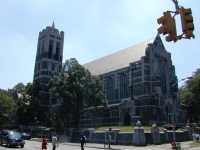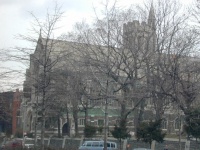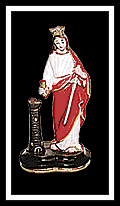From The Peopling of New York City
Contents |
Religion of Dominicans
Faith

Adherents to the Protestant faith form the second largest religious denomination, however, they are still a small percentage of the overall population (<9%). Strict Spriritists comprise about 1% of the population, but many who may profess another religion, such as Roman Catholicism, may also practice Spiritism in the form of Santeria secretly.
Santeria
When we speak of Dominican spiritists, we are referring to those who practice Santeria, a form of worship closely related to Spiritism. Santeria is a faith where certain elements form Catholicism are combined with elements of West African, usually Yoruba, belief and practice. Recently, this religion has become wildly popular in New York, as evidenced by the numerous botanicas, (shops specializing in Santeria paraphernalia e.g. crosses, amulets and various fetishes) listed in the yellow pages, far more than for any other religious store. Elements of Santeria can be found in some popular latin music and literature, and, over time, its practice has become more secular and cultural than religious.This practice originated among slaves exported to the America’s, between 1770 – 1840. Prohibited from worshipping their own Gods, and forcibly converted to Catholicism, they renamed their own deities after the ‘Christian’ saints, and continued their worship secretly in an effort to keep their traditions alive. Catholic Saints were given identities corresponding to African Gods with similar traits. (This practice of merging beliefs is called Syncretism.)
Santeros, practitioners of Santeria, worship one supreme lord, and a group of lesser deities called Orisha from the Yoruban Pantheon.Priests use divination to ascertain the will of Orisha, who are said to possess their worshippers when they wish to communicate. Prayers; Sacrifices of animals: chickens, goats, turtles; music (drums are used to invoke various Orisha, with a particular rhythm associated with each God); Altars; dancing are all involved in its practice. Ordinary rituals are held in private homes, rather than set place of worship (e.g. temples). Practitioners focus on the present, rather than some sort of afterlife, and natural forces play a key role. Generally, “Followers belong to a specific community with a male or female santero serving as godparent, counselor, and priest for the community.” Given the strong sense of community emphasized, it is not suprising that it has a large following among immigrants from countries where it is practiced. It draws them together, and reminds them of the old country.
References
http://www.google.com/imgres?imgurl=http://graphics8.nytimes.com/images/2007/03/04/nyregion/domi600.jpg&imgrefurl=http://www.nytimes.com/2007/03/04/nyregion/thecity/04domi.html&h=320&w=600&sz=76&tbnid=_U3muZVhU-_ceM::&tbnh=72&tbnw=135&prev=/images%3Fq%3Dpictures%2Bof%2Bwashington%2Bheights&hl=en&usg=__-EFfZDg3cordH8iNLYbfAxHV9Ps=&ei=a-7rSf-XB4WHtgeWytSXBg&sa=X&oi=image_result&resnum=3&ct=image
http://cityroom.blogs.nytimes.com/2009/03/20/ask-about-dominicans-in-new-york-part-3/
http://www.nyu.edu/classes/blake.map2001/dominican2.html
http://en.wikipedia.org/wiki/Dominican_American#cite_note-5
http://www.earthinstitute.columbia.edu/cgsd/advising/documents/rivera_batiz.pdf
http://www.everyculture.com/multi/Bu-Dr/Dominican-Americans.html
http://www.watchtower.org/e/20000708a/article_01.htm
http://www.eric.ed.gov:80/ERICDocs/data/ericdocs2sql/content_storage_01/0000019b/80/17/34/68.pdf
- Return to Religion
- Return to Dominicans

